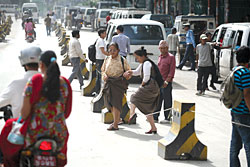 PICS: KIRAN PANDAY |
You don't need to be an expert to see that traffic congestion in Kathmandu is bad. Vehicles clog narrow roads, microbus drivers stop anywhere they want, and traffic police rarely make themselves useful. But without an integrated plan to address traffic problems across the valley's three districts and various traffic regulation agencies, a solution may be beyond our reach.
Under the Local Self Governance Act 1999, local bodies planned and implemented policies independently, according to the needs of their localities. The arrangement served the political parties well, since it enabled them to get votes more easily, but an integrated plan was politically unfeasible. The costs of this arrangement are rapidly climbing as traffic gets worse. It's clear what needs to done.
The number of cars has increased 10-fold over the last 15 years - largely because banks have had few other viable investment opportunities amid deteriorating security conditions - and only 126km of new roads have been constructed. According to the Department of Transport Management, there are 444,700 registered vehicles in Bagmati zone, most in the Kathmandu Valley.
And things will only get worse. "If it takes half an hour to cross the Bagmati bridge now, you won't be able cross the bridge in three years time," says David Irwin, team leader of the Kathmandu Sustainable Urban Transport Project, funded by the Asian Development Bank.
The project will assist the government in defining a sustainable urban transport vision to be progressively implemented over the years to come. It focuses on the dramatic increase in private vehicles in the capital.
"Construction of flyovers and wider roads alone cannot improve the traffic situation as the number of private vehicles increase at the same rate," argues Irwin. He says improving the existing road network and encouraging proper use of roads is a sustainable and doable solution. "Acquisition of land to widen roads is too expensive so the initial solution is to include various measures to reduce the volume of traffic and to improve the quality of public transportation," he says.
The government could raise annual and import taxes on vehicles, and pull unviable vehicles off the road, in order to cut the growth in private vehicles. However, although what is necessary is clear, implementation will be difficult because of a lack of coordination among traffic monitoring and regulating agencies.
The responsibilities are split up among various groups that don't communicate adequately with one another: the Department of Roads repairs city roads, the Department of Transport Management registers and regulates vehicles, the Traffic Police supervise and enforce traffic regulations, the Ministry of Environment monitors air quality and the Department of Urban Development and Building Construction is responsible for strategic roads and city planning while municipalities construct local roads and parking spaces.
"Naturally, it will be difficult to coordinate with departments that are under different ministries," says Deputy Inspector General of Police Binod Singh at the Metropolitan Traffic Police Division. The Traffic Police fall under the home ministry.
 |
Singh gives an example of the problems this interconnectedness gives rise to: while it is necessary to revise traffic acts and regulations in order to increase penalties for traffic offenders, this is impossible unless roads are widened first, which the Traffic Police don't have the power to do.
It's also unclear how to regulate traffic under a federal framework. Take the Outer Ring Road project, which was first tabled in 2005. While the planned road would be 50m wide, the government must also acquire 250m of land on either side through land pooling.
The project has prepared a detailed report for 32km out of 72km and land pooling began across a 6.5km stretch between Chobhar and Satungal. But the Newa Rajya Committee, a federalist group, opposes the idea, calling it a 'ploy to replace locals with outside people.'
"They asked us to postpone the project until the issue of federalism is finalised," says Dilip Bhandari, Senior Divisional Engineer of the project, "We will soon hold a meeting with representatives of political parties, locals and stakeholders."
Until the powers that be discover a unified theory of traffic management, it seems Point A to Point B will be a long way from just that.


